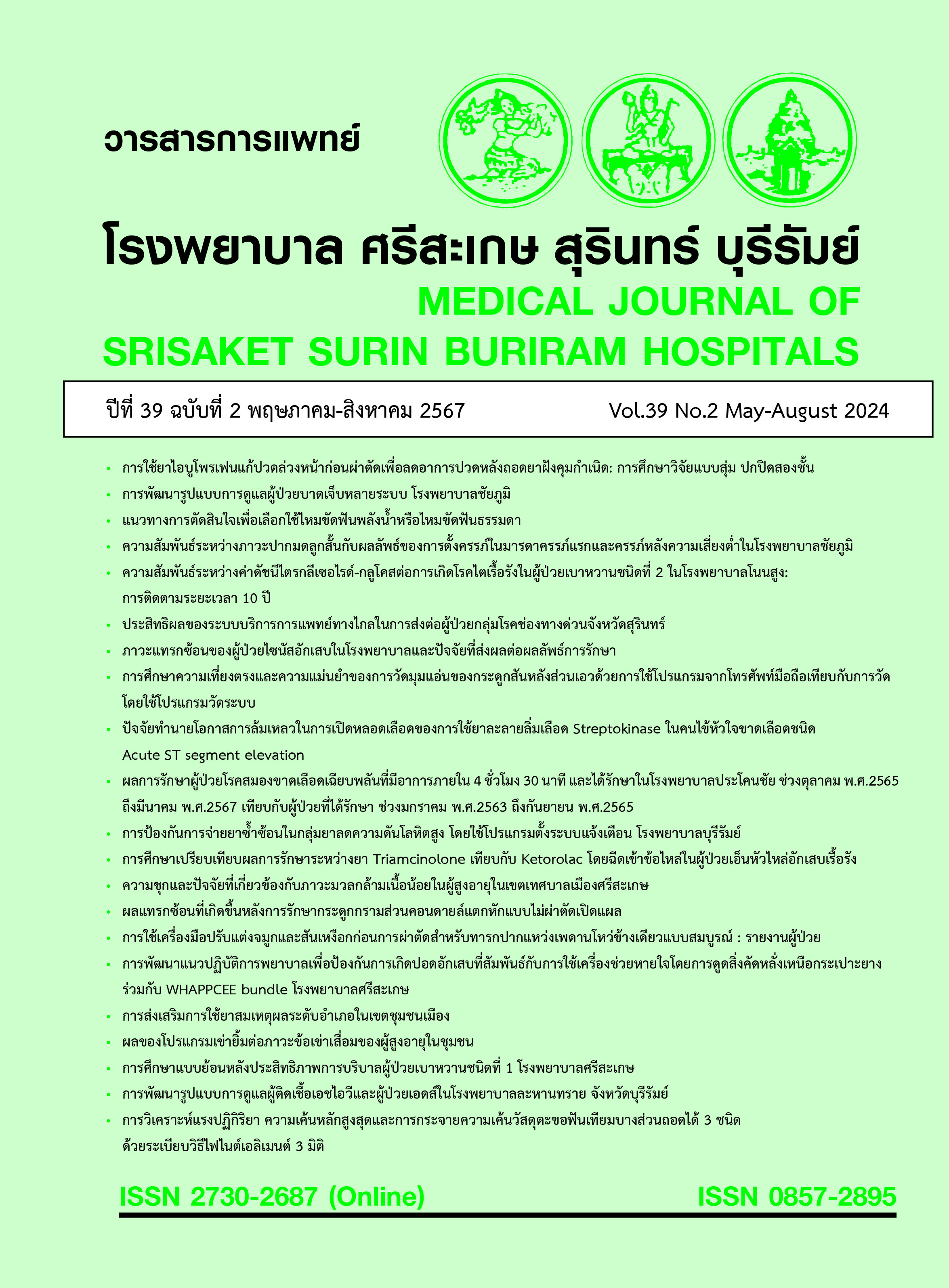ประสิทธิผลของระบบบริการการแพทย์ทางไกลในการส่งต่อผู้ป่วยกลุ่มโรคช่องทางด่วนจังหวัดสุรินทร์
Main Article Content
บทคัดย่อ
หลักการและเหตุผล: ระบบส่งต่อผู้ป่วยเป็นองค์ประกอบสำคัญของระบบรักษาพยาบาลฉุกเฉิน แต่บุคลากรเฉพาะทางในเครือข่ายมีจำกัด จึงอาจเกิดการดูแลที่ไม่เหมาะสม โดยเฉพาะผู้ป่วยกลุ่มโรคช่องทางด่วนซึ่งมีความซับซ้อนในการดูแล การนำระบบบริการการแพทย์ทางไกลมาใช้ในการส่งต่อจะช่วยเพิ่มคุณภาพการดูแล
วัตถุประสงค์: เพื่อศึกษาประสิทธิผลของระบบบริการการแพทย์ทางไกลที่ใช้ระหว่างโรงพยาบาลสุรินทร์และโรงพยาบาลอำเภอถึงความเหมาะสมในการดูแลผู้ป่วยกลุ่มโรคช่องทางด่วนในช่วงก่อนและขณะส่งต่อ, ความรุนแรงของโรคที่เปลี่ยนแปลงไปหลังส่งต่อ, อัตราการเสียชีวิตภายใน 24 ชั่วโมง และ 30 วันหลังส่งต่อ
วิธีการศึกษา: เป็นการวิจัยกึ่งทดลอง กลุ่มตัวอย่างเป็นผู้ป่วยโรคช่องทางด่วนที่ส่งต่อจากโรงพยาบาลอำเภอมาโรงพยาบาลสุรินทร์ ระหว่างวันที่ 10 สิงหาคม ถึงวันที่ 21 พฤศจิกายน พ.ศ. 2566 เก็บข้อมูลก่อนและหลังดำเนินการระบบบริการการแพทย์ทางไกล วิเคราะห์ข้อมูลโดยใช้ Student's t-test, Wilcoxon rank-sum test, Pearson's Chi-squared test, Fisher's exact test และ Relative risk (95% CI)
ผลการศึกษา: ผู้ป่วย 1,022 คน เป็นกลุ่มก่อนดำเนินการระบบ 495 คน และหลังดำเนินการ 527 คน พบว่าหลังดำเนินการการดูแลเหมาะสมมากกว่า (93.7% vs 78.6%, RR 1.19, 95% CI 1.13-1.25, p-value < 0.001) ค่ามัธยฐานของ Modified Early Warning Score ที่ลดลงหลังส่งต่อมีค่ามากกว่า (2 vs 0, p-value < 0.001) ส่วนอัตราการเสียชีวิตภายใน 24 ชั่วโมงและ 30 วันไม่แตกต่างกัน (p-value 0.268, 0.465)
สรุป: การใช้ระบบบริการการแพทย์ทางไกลช่วยเพิ่มความเหมาะสมในการดูแลและลดความรุนแรงของโรคในผู้ป่วยกลุ่มโรคช่องทางด่วนที่ได้รับการส่งต่อ
Article Details

อนุญาตภายใต้เงื่อนไข Creative Commons Attribution-NonCommercial-NoDerivatives 4.0 International License.
เอกสารอ้างอิง
Rokos IC, Sanddal ND, Pancioli AM, Wolff C, Gaieski DF. Inter-hospital communications and transport: turning one-way funnels into two-way networks. Acad Emerg Med 2010;17(12):1279-85. doi: 10.1111/j.1553-2712.2010.00929.x.
Tsou C, Robinson S, Boyd J, Jamieson A, Blakeman R, Yeung J, et al. Effectiveness of Telehealth in Rural and Remote Emergency Departments: Systematic Review. J Med Internet Res 2021;23(11):e30632. doi: 10.2196/30632.
Mohr NM, Young T, Harland KK, Skow B, Wittrock A, Bell A, et al. Emergency Department Telemedicine Shortens Rural Time-To-Provider and Emergency Department Transfer Times. Telemed J E Health 2018;24(8):582-93. doi: 10.1089/tmj.2017.0262
Westbrook JI, Coiera EW, Brear M, Stapleton S, Rob MI, Murphy M, et al. Impact of an ultrabroadband emergency department telemedicine system on the care of acutely ill patients and clinicians' work. Med J Aust 2008;188(12):704-8. doi: 10.5694/j.1326-5377.2008.tb01850.x.
Dharmar M, Kuppermann N, Romano PS, Yang NH, Nesbitt TS, Phan J, et al. Telemedicine consultations and medication errors in rural emergency departments. Pediatrics 2013;132(6):1090-7. doi: 10.1542/peds.2013-1374.
Lieng MK, Siefkes HM, Rosenthal JL, Sauers-Ford HS, Mouzoon JL, Sigal IS, et al.
Telemedicine for Interfacility Nurse Handoffs. Pediatr Crit Care Med 2019;20(9):832-40. doi: 10.1097/PCC.0000000000002011.
Natafgi N, Shane DM, Ullrich F, MacKinney AC, Bell A, Ward MM. Using tele-emergency to avoid patient transfers in rural emergency departments: An assessment of costs and benefits.
J Telemed Telecare 2018;24(3):193-201. doi: 10.1177/1357633X17696585
Kleinrok A, Płaczkiewicz DT, Puźniak M, Dąbrowski P, Adamczyk T. Electrocardiogram teletransmission and teleconsultation: essential elements of the organisation of medical care for patients with ST segment elevation myocardial infarction: a single centre experience. Kardiol Pol 2014;72(4):345-54. doi: 10.5603/KP.a2013.0352.
Chalouhi N, Dressler JA, Kunkel ES, Dalyai R, Jabbour P, Gonzalez LF, et al. Intravenous tissue plasminogen activator administration in community hospitals facilitated by telestroke service. Neurosurgery 2013;73(4):667-71; discussion 671-2. doi: 10.1227/NEU.0000000000000073.
Meyer BC, Raman R, Hemmen T, Obler R, Zivin JA, Rao R, et al. Efficacy of site-independent telemedicine in the STRokE DOC trial: a randomised, blinded, prospective study. Lancet Neurol 2008;7(9):787-95. doi: 10.1016/S1474-4422(08)70171-6.
Johansson T, Wild C. Telemedicine in acute stroke management: systematic review. Int J Technol Assess Health Care 2010;26(2):149-55. doi: 10.1017/S0266462310000139.
Rincon TA, Bourke G, Seiver A. Standardizing sepsis screening and management via a tele-ICU program improves patient care. Telemed J E Health 2011;17(7):560-4. doi: 10.1089/tmj.2010.0225.
Marx G, Greiner W, Juhra C, Elkenkamp S, Gensorowsky D, Lemmen S, et al. An Innovative Telemedical Network to Improve Infectious Disease Management in Critically Ill Patients and Outpatients (TELnet@NRW): Stepped-Wedge Cluster Randomized Controlled Trial. J Med Internet Res 2022;24(3):e34098. doi: 10.2196/34098.
Mohr NM, Campbell KD, Swanson MB, Ullrich F, Merchant KA, Ward MM. Provider-to-provider telemedicine improves adherence to sepsis bundle care in community emergency departments. J Telemed Telecare 2021;27(8):518-26. doi: 10.1177/1357633X19896667.
Tu KJ, Wymore C, Tchangalova N, Fuller BM, Mohr NM. The impact of telehealth in sepsis care: A systematic review. J Telemed Telecare 2023:1357633X231170038. doi: 10.1177/1357633X231170038.
Duchesne JC, Kyle A, Simmons J, Islam S, Schmieg RE Jr, Olivier J, et al. Impact of telemedicine upon rural trauma care. J Trauma 2008;64(1):92-7. doi: 10.1097/TA.0b013e31815dd4c4.
Mohr NM, Vakkalanka JP, Harland KK, Bell A, Skow B, Shane DM, et al. Telemedicine Use Decreases Rural Emergency Department Length of Stay for Transferred North Dakota Trauma Patients. Telemed J E Health 2018;24(3):194-202. doi: 10.1089/tmj.2017.0083.
Latifi R, Hadeed GJ, Rhee P, O'Keeffe T, Friese RS, Wynne JL, et al. Initial experiences and outcomes of telepresence in the management of trauma and emergency surgical patients. Am J Surg 2009;198(6):905-10. doi: 10.1016/j.amjsurg.2009.08.011.
Goh KY, Lam CK, Poon WS. The impact of teleradiology on the inter-hospital transfer of neurosurgical patients. Br J Neurosurg 1997;11(1):52-6. doi: 10.1080/02688699746708.
Stevenson A, Fiddler C, Craig M, Gray A. Emergency department organisation of critical care transfers in the UK. Emerg Med J 2005;22(11):795-8. doi: 10.1136/emj.2004.017822.


